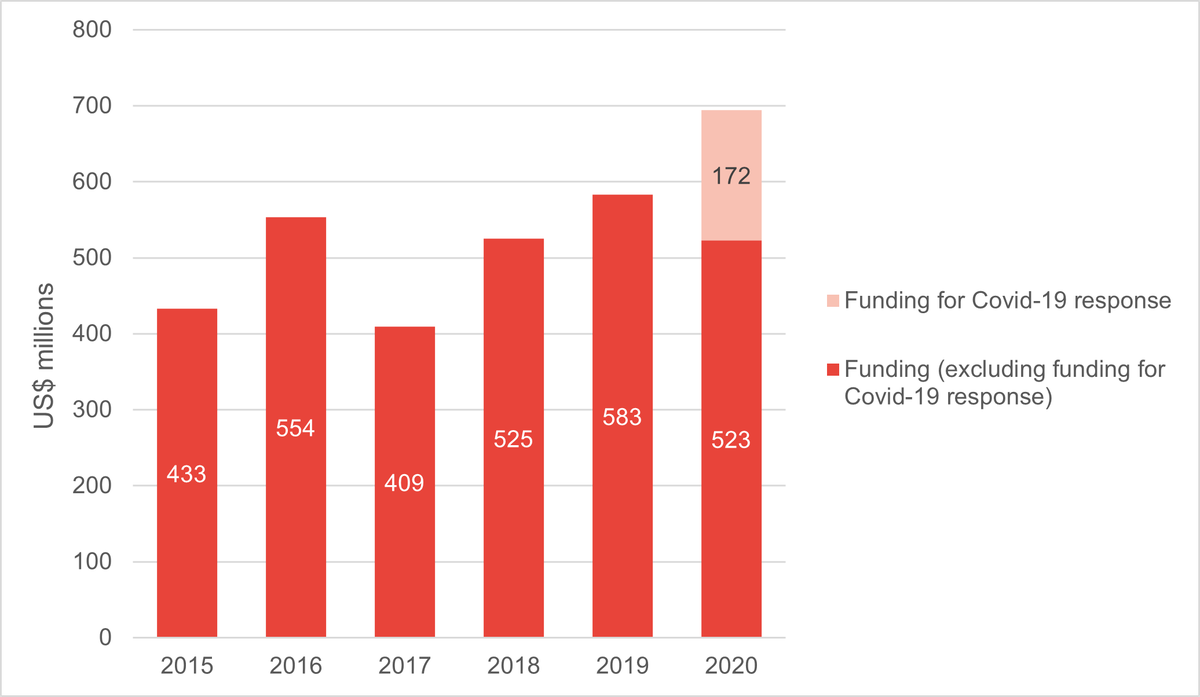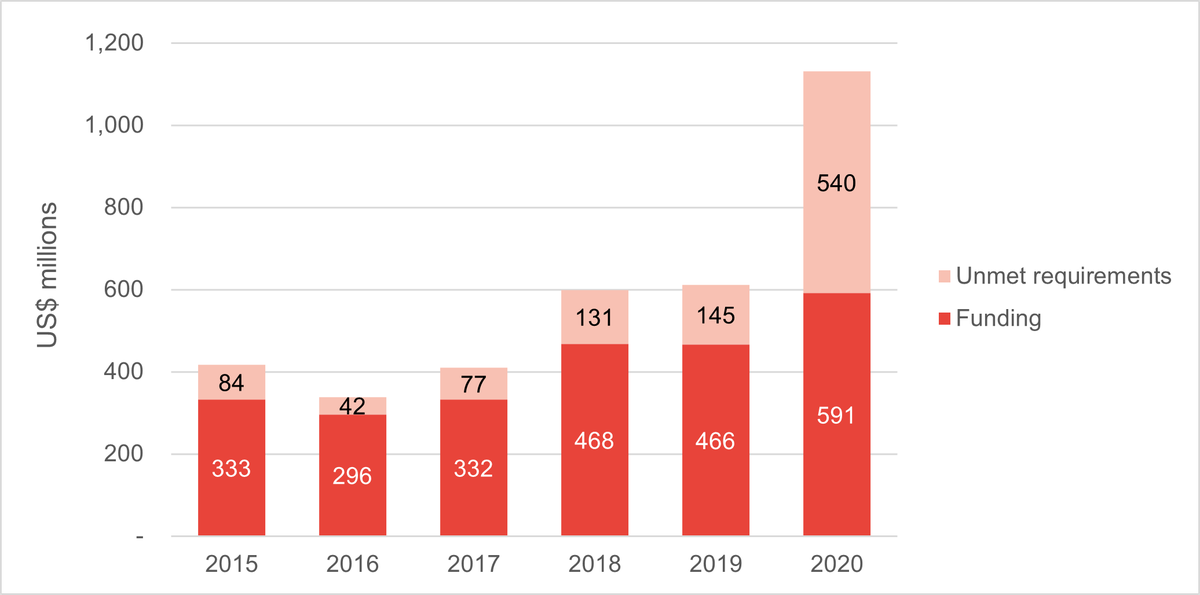The cost of leaving Afghans behind
Aid to Afghanistan is stagnating despite the desperate need for funding. Donors must come together to ensure that this does not become the new normal for such crises.
As world leaders convene in Geneva today to avoid a humanitarian catastrophe following the fall of Kabul, our research shows aid to crisis-hit countries like Afghanistan is stagnating despite the desperate need for funding. Donors must come together to ensure that this does not become the new normal.
The Taliban takeover of Afghanistan in August 2021 is the most recent reversal of fortune for the country, which is one of the most fragile and aid-dependent in South Asia . While some Afghans have been able to escape Taliban rule, the majority have no choice but to stay. Now, as the country moves into a new phase of its challenging history, the extent to which Afghans are left behind in the wider social and economic sense will be in part determined by the international response.
On top of the aftermath of the US troops withdrawal, the effects of Covid-19 and an imminent economic collapse, the second major drought in four years and the disruption in food supplies is putting thousands of people at risk of mass starvation . More than half of all children under-five are at risk of acute malnutrition. According to UN estimates, these pre-existing crises have already put around half of Afghanistan's total population (18 million) in need of urgent humanitarian support – this is even before the implications of mass migration in response to the Taliban takeover is taken into consideration.
This emergency has triggered the conference today in Geneva, during which the UN will call on global leaders to scale-up vital assistance to avoid one the worst humanitarian catastrophes of the 21st century. Policymakers face the stark challenge of how to meet, not only the immediate humanitarian needs of millions of Afghans, but also contribute to their future safety, prosperity and dignity.
In 2015, the international community, under the auspices of the UN, committed to leave no one behind through the Sustainable Development Goals (SDGs). This commitment applies to everyone, everywhere – including the people of Afghanistan. The international community must now redouble its global commitments, which requires delivering humanitarian assistance and ensuring the concerted and sustained engagement of those working to support longer-term development in an unstable, crisis context.
In the immediate humanitarian response the dilemma for donors is evident: how to balance the provision of relief to the Afghan people and the safety of their staff in the current political crisis? The IMF and the World Bank have temporarily put their aid to Afghanistan on hold. The EU , the UK and the US , meanwhile, have announced possible humanitarian aid but have rejected directly financing the new government led by the Taliban.
The crisis in Afghanistan is one of many examples of a worrying trend in humanitarian assistance: an increasing gap between the life-saving resources needed and the amount provided. After two decades monitoring aid flows to crisis settings at Development Initiatives , 2020 saw a record shortfall in global humanitarian funding of US$18.8 billion. Only half (52%) of the humanitarian need identified by the UN through its coordinated appeals process were met.
Despite escalating levels of humanitarian need globally – with funding required to respond to the impacts of Covid-19 as well as other emerging and pre-existing needs – the total amount of humanitarian funding provided by governments stagnated between 2019 and 2020, with US$24.1 billion allocated.
In other words, crisis settings like Afghanistan risk even further chronic underfunding. In 2020, Afghanistan received only half (52%) of the humanitarian funding it needed. This has put thousands of vulnerable people at risk, especially children, women, girls, the elderly and people with disabilities who have much more limited options in crisis contexts.
Figure 1: International Humanitarian Assistance to Afghanistan, 2015–2020

A chart showing the international humanitarian assistance to Afghanistan from 2015 to 2020.
Source: Development Initiatives based on UN OCHA FTS data.
Notes: Data is in constant 2019 prices and was last updated on 1 September 2021.
Figure 2: Afghanistan Humanitarian Response Plan: Funding vs Requirements, 2015–2020

A chart showing the funding and unmet requirements in Afghanistan's humanitarian response plan from 2015 to 2020.
Source: Development Initiatives based on UN OCHA FTS data.
Notes: HRP = Humanitarian Response Plan. Data is in current prices and was last updated on 9 August 2021.
The further consequences of the Afghan humanitarian catastrophe will be devastating in the region and beyond if funding commitments continue to fall short of needs or are, worse yet, entirely cut off.
Humanitarian agencies and NGOs that have remained in Afghanistan have been promoting a clear and simple message after the majority of the international community departed from the country: “stay and deliver” .
Relief organisations, which have been effectively providing relief to Taliban-controlled areas prior to the recent fall of the US-backed government, can teach us important lessons about the future of aid to Afghanistan. Negotiating safe routes for humanitarian staff and equipment must be the priority when negotiating with the new government. This is especially true for female humanitarian workers, who are one of the few international field-based staff who can maintain an already fragile protection network for victims of gender-based violence.
The notion of engaging with the Taliban to ensure humanitarian assistance may not appeal to most donors. Yet, this hesitancy must be weighed against the consequences of doing nothing at all.
The imperative is to respond to the urgent, uncertain and fast evolving humanitarian crisis in Afghanistan. Yet, a longer-term view is also needed – one that considers when, how and in what form support can be provided to Afghans so they can build better futures. Ultimately, the country will need to break out of cycles of protracted crisis to ensure millions of Afghans are not left behind.
This challenge is not unique to Afghanistan. It is a depressingly familiar and growing trend as more countries face years, in some cases decades, of conflict and recurrent natural disasters . In these countries, as well as in Afghanistan, it is people living in the highest levels of poverty that are being left behind. These are development as well as humanitarian crises.
Providing assistance in protracted crises like Afghanistan is not easy for development actors. These are fragile, conflict-prone settings where the traditional model of government partnerships following an agreed national development plan is not always possible. As a result, achieving a given outcome is less certain and potentially more costly. Yet, working in these contexts must become the new norm if both immediate humanitarian needs as well as sustained global social, environmental and economic progress are to be achieved.
Development actors are acknowledging the need to work more and better in crisis contexts. The World Bank, for instance, has made strides to innovate their assistance for fragile countries by developing a range of instruments and tools to better respond to crises, such as the Crisis Response Window which disbursed US$3 billion between 2011 and 2018 in response to 27 crises.
If the moral justification for humanitarian and development actors to continue to engage in Afghanistan is not enough, a politically pragmatic argument may also prove the point. Global powers like Russia and China have been anxiously waiting for the US withdrawal to extend their influence in the region, and will likely support their new counterparts in Kabul. The absence of traditional donors could fuel a hostile narrative against the West in Afghanistan, especially given the speed with which the US and its allies left the country and seemingly abandoned their former allies.
It is noteworthy that 70-80% of the former government’s budget was funded through Official Development Assistance. The Taliban-led government are aware of the fact that their old but rather profitable business model , which was based on narcotics production, illegal mining and extortion rackets, is not enough to run a functioning state. This realisation may be one of the reasons why statements from English-speaking Taliban spokesmen have proliferated in Western media in recent weeks promising respect for women’s rights and traitors to their cause.
From a global health perspective, Afghanistan cannot become isolated from the worldwide vaccine efforts. Only 2.6% of the total population has been vaccinated against Covid-19 . Thousands of people potentially fleeing the country could contribute to the risk of new variants and infection rates in neighbouring countries.
The pandemic, climate hazards, food insecurity and the conflict in particular combine to set a scene of humanitarian instability in Afghanistan. Our decades of research on the global humanitarian landscape illustrates that we cannot risk leaving Afghans behind at this time of crisis. Insufficient humanitarian funding was already putting thousands of vulnerable people at risk, further narrowing their limited options in the face of crisis. Donors must work together and innovate in response, ensuring that continued support in these contexts is the new normal.
Related content
Priorities for the UK’s incoming Secretary of State Alok Sharma
As Alok Sharma takes office as Secretary of State, DI's Amy Dodd sets out key priorities for the UK and its global development agenda.
From review to delivery on the Global Goals – what should the immediate priorities be for the UK government?
On 26 June, the UK government published its Voluntary National Review measuring delivery against the Global Goals - but does it accurately capture progress?
Three priorities for the High-level Political Forum 2019
DI Director of Partnerships & Engagement Carolyn Culey sets out three key priorities for closing the gap between the poorest and the rest at HLPF 2019